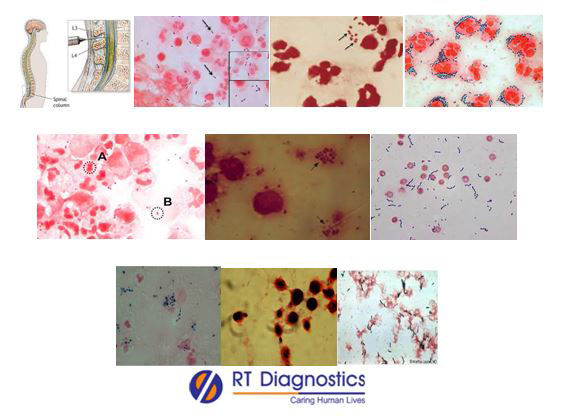Gram Stain – CSF:
Why Gram Stain (CSF) Test?
CLINICAL INFORMATION
CSF is Cerebro-Spinal Fluid is a body fluid that flows in the space around the spinal cord and brain. Gram stain also called as Gram stain method used for staining to classify two groups of bacterial species such as gram-positive and gram-negative bacteria. This term Gram stain is derived from the Danish bacteriologist Hans Christian Gram who developed this technique. Gram staining differentiates bacteria by the physical and chemical properties of the bacterial cell wall. Bacteria with gram-positive cell walls have a thick peptidoglycan which retains the primary stain crystal violet and Lugol’s iodine solution is added to strengthen the bonds of the stain. While the gram-negative bacteria since they have a thinner bacterial cell wall allow the crystal violet to wash out on addition of ethanol, hence their cell membrane is stained pink or red by the counterstain (safranin or fuchsine). CSF Gram Stain test helps in the diagnosis of detecting harmful microbial pathogens (meningitis etc) in the CSF fluid that may affect the brain and cause neurological manifestations. Thus this test helps in reducing the occurrence of neurological complications caused by infectious disease-causing pathogens. Gram Stain Test: This test checks for the presence of harmful pathogenic microbes in suspected infection, for example in the throat, lungs, skin wounds, genitals etc and moreover in body fluids such as blood, urine etc. The two main categories of bacterial infections are gram-positive and gram-negative. This screening for diagnosis is done by the differentiation made, based on how the bacteria react to the gram stain. A gram stain is coloured purple and if the bacteria remain in purple colour it is gram-positive bacteria and incases the bacteria turns red or pink they are gram-negative bacteria. Examples of gram-positive bacteria include nosocomial infection caused by methicillin resistant Streptococcus aureus (MRSA), Strep infections, toxic shock etc. Examples of gram-negative infections include Salmonella, pneumonia, gonorrhea, UTI etc. The significance of differentiating the nature of bacteria as gram-positive or gram-negative helps the physician to begin the most effective antibiotic therapy for treating it. If the test result shows the presence of more than (≥15) colonies along with the same organism isolated from peripheral blood along with clinical signs and symptoms, then the case is said to be an infected positive case. Other gram stain tests include the Acid Fast Test (eg. For mycobacterium causing TB etc). Clinical manifestations include chills, fever, fatigue, nausea, confusion, increased heart rate, nasal flare due to increased breathing -which may or may not be associated with shortness of breath on physical exertion, inflammation (presenting with cardinal signs of inflammation like – rubor, tumor, calor, dolor and loss of function), blood clots, drop in blood pressure, organ failure, elevated WBCs etc. Once tested positive, then the additional supportive tests are ordered for - Evidence-Based Therapy (EBT) such as CBC, test for the presence of bacterial toxins (release of toxic by-products) eg staphylococcal infection, in case of foodborne-illness/food poison (or their toxins), different sample specimen collected for tests eg. blood, stool, urine culture, sputum test, CSF sampling, ascetic fluid, pleural fluid, pericardial fluid, synovial fluid, complement test (to check for increased levels of C3) etc. Moreover, sensitivity tests (also known as susceptibility testing) are also performed in addition, to appropriate antibiotic treatment & for better prognosis eg. MRSA – Methicillin-Resistant Staphylococcus aureus, VMSA – Vancomycin-Resistant Staphylococcus aureus etc. Other tests other than culture and sensitivity of semen for the source of infection includes microscopic examination and evaluation of semen analysis, blood tests like CBC, differential WBC count (in case of infection), Prostate-Specific Antigen test, testosterone, FSH, ELISA test for Mumps antibodies etc, other hormonal assays eg. pituitary hormones (in case of tumours etc), urinalysis to check for UTI, digital rectal examination to confirm pain and swelling of the prostate, CT Scan, ultrasound (vericocele), genetic tests like DNA etc.

General Instructions:
Sample Requirement:Specimen - CSF. Test Preparation: None.
NOTE - Sample for specimen collections may vary based on the patient’s condition/cases according to the patient’s presenting complaints/signs or symptoms:
SPECIMEN REQUIREMENT (Special or Rare Cases) - As instructed and guided by Physician / Clinician / Pathologist / as per Laboratory’s requirements, according to procedures and protocols.
This Multi-Specialty Clinical Referral Laboratory RT DIAGNOSTICS provides precise and accurate tests with an extensive range of testing services to the medical centres to help in the diagnosis and identification of pathology in the test specimens for infectious diseases and also to evaluate the function of organ systems of the patient. It prevents further complications and helps to stabilize and restore health to near normalcy at the earliest without delay.



